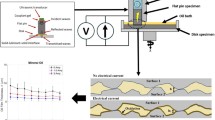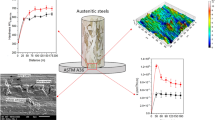Abstract
In the present investigation, soft materials, such as Al-4Mg alloy, high-purity Al and pure Mg pins were slid against hard steel plates of various surface textures to study the response of materials during sliding. The experiments were conducted using an inclined pin-on-plate sliding apparatus under both dry and lubricated conditions in an ambient environment. Two kinds of frictional response, namely steady-state and stick-slip, were observed during sliding. In general, the response was dependent on material pair, normal load, lubrication, and surface texture of the harder material. More specifically, for the case of Al-4Mg alloy, the stick-slip response was absent under both dry and lubricated conditions. For Al, stick-slip was observed only under lubricated conditions. For the case of Mg, the stick-slip response was seen under both dry and lubricated conditions. Further, it was observed that the amplitude of stick-slip motion primarily depends on the plowing component of friction. The plowing component of friction was the highest for the surfaces that promoted plane strain conditions and was the lowest for the surfaces that promoted plane stress conditions near the surface.








Similar content being viewed by others
References
N.P. Suh, Tribophysics, Prentice-Hall, Englewood Cliffs, NJ, 1986
F.P. Bowden and D. Tabor, The Friction and Lubrication of Solids, Clarendon, Oxford, 1954
S. Bouissou, J.P. Petit, and M. Barquins, Normal Load, Slip Rate and Roughness Influence on the Polymethylmethacrylate Dynamics of Sliding 1. Stable Sliding to Stick-Slip Transition, Wear, 1998, 214(2), p 156–164
D.H. Hwang and K.H.Z. Gahr, Transition from Static to Kinetic Friction of Unlubricated or Oil Lubricated Steel/Steel, Steel/Ceramic and Ceramic/Ceramic Pairs, Wear, 2003, 255(1–6), p 365–375
W. Rasp and C.M. Wichern, Effects of Surface-Topography Directionality and Lubrication Condition on Frictional Behaviour during Plastic Deformation, J. Mater. Process. Technol., 2002, 125–126, p 379–386
E. Schedin, Galling Mechanisms in Sheet Forming Operations, Wear, 1994, 179(1–2), p 123–128
D.O. Bello and S. Walton, Surface Topography and Lubrication in Sheet Metal Forming, Tribol. Int., 1987, 20(2), p 59–65
P.K. Saha, W.R.D. Wilson, and R.S. Timsit, Influence of Surface Topography on the Frictional Characteristics of 3104 Aluminum Alloy Sheet, Wear, 1996, 197(1-2), p 123–129
M.R. Lovell, Z. Deng, and M.M. Khonsari, Experimental Characterization of Sliding Friction: Crossing from Deformation to Plowing Contact, ASME: J. Tribol., 2000, 122(4), p 856–863
R. Lakshmipathy and R. Sagar, Effect of Die Surface Topography on Die-Work Interfacial Friction in Open Die Forging, Int. J. Mach. Tools Manuf., 1992, 32(5), p 685–693
A. Määttä, P. Vuoristo, and T. Mäntylä, Friction and Adhesion of Stainless Steel Strip Against Tool Steels in Unlubricated Sliding with High Contact Load, Tribol. Int., 2001, 34(11), p 779–786
H.E. Staph, H.E. Staph, P.M. Ku, and H.J. Carper, Effect of Surface Roughness and Surface Texture on Scuffing, Mech. Mach. Theory, 1973, 8, p 197–208
M.M. Koura, The Effect of Surface Texture on Friction Mechanisms, Wear, 1980, 63(1), p 1–12
S. Malayappan and R. Narayanasamy, An Experimental Analysis of Upset Forging of Aluminium Cylindrical Billets Considering the Dissimilar Frictional Conditions at Flat Die Surfaces, Int. J. Adv. Manuf. Technol., 2004, 23(9–10), p 636–643
P.L. Menezes, Kishore, and S.V. Kailas, Effect of Roughness Parameter and Grinding Angle on Coefficient of Friction When Sliding of Al-Mg Alloy Over EN8 Steel, ASME: J. Tribol., 2006, 128(4), p 697–704
P.L. Menezes, Kishore, and S.V. Kailas, Effect of Directionality of Unidirectional Grinding Marks on Friction and Transfer Layer Formation of Mg on Steel using Inclined Scratch Test, Mater. Sci. Eng. A, 2006, 429(1–2), p 149–160
T.E. Fischer, S. Bhattacharya, and R. Salher, Lubrication by a Smectic Liquid Crystal, Tribol. Trans., 1988, 31(4), p 442–448
B.J. Hamrock and D. Dowson, Ball Bearing Lubrication—The Elastohydrodynamics of Elliptical Contact, Wiley, New York, 1981
G.W. Stachowiak and A.W. Batchelor, Engineering Tribology, Butterworth Heinemann, Boston, 2001, p 312–313
K. Tanaka, T. Kato, and Y. Matsumoto, Molecular Dynamics Simulation of Vibrational Friction Force due to Molecular Deformation in Confined Lubricant Film, ASME: J. Tribol., 2003, 125(3), p 587–591
M.L. Gee, P.M. McGuiggan, and J.N. Israelachvili, Liquid to Solid Like Transitions of Molecularly Thin Films under Shear, J. Chem. Phys., 1990, 93(3), p 1895–1906
A.L. Demirel and S. Granick, Transition from Static to Kinetic Friction in a Model Lubricated System, J. Chem. Phys., 1998, 109(16), p 6889–6897
X. Ai and H.S. Cheng, The Effects of Surface Texture on EHL Point Contacts, ASME: J. Tribol., 1996, 118(1), p 59–66
D.H. Buckley and R.L. Johnson, The Influence of Crystal Structure and Some Properties of Hexagonal Metals on Friction and Adhesion, Wear, 1968, 11(6), p 405–419
Z.N. Farhat, Contribution of Crystallographic Texturing to the Sliding Friction Behaviour of FCC and HCP Metals, Wear, 2001, 250(1–12), p 401–408
F.-X. Wang, P. Lacey, R.S. Gates, and S.M. Hsu, A Study of the Relative Surface Conformity Between Two Surfaces in Sliding Contact, ASME: J. Tribol., 1991, 113(4), p 755–761
N. Yoshioka, A Review of the Micromechanical Approach to the Physics of Contacting Surfaces, Tectonophysics, 1997, 277(1-3), p 29–40
P. Sahoo and S.K.R. Chowdhury, A Fractal Analysis of Adhesive Wear at the Contact Between Rough Solids, Wear, 2002, 253(9-10), p 924–934
K. Varadi, Z. Neder, and K. Friedrich, Evaluation of the Real Contact Areas, Pressure Distributions and Contact Temperatures during Sliding Contact between Real Metal Surfaces, Wear, 1996, 200(1–2), p 55–62
Author information
Authors and Affiliations
Corresponding author
Rights and permissions
About this article
Cite this article
Menezes, P.L., Kishore, Kailas, S.V. et al. Response of Materials During Sliding on Various Surface Textures. J. of Materi Eng and Perform 20, 1438–1446 (2011). https://doi.org/10.1007/s11665-010-9795-x
Received:
Published:
Issue Date:
DOI: https://doi.org/10.1007/s11665-010-9795-x




